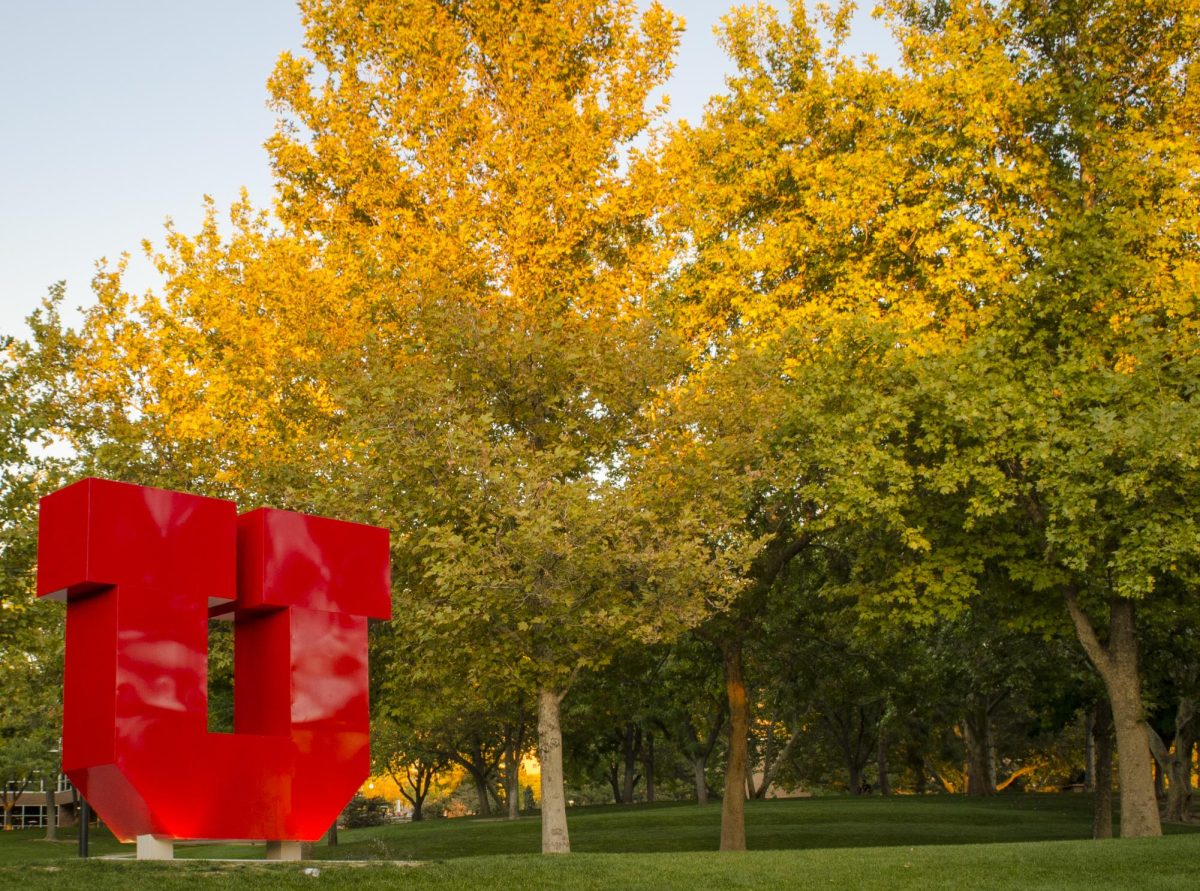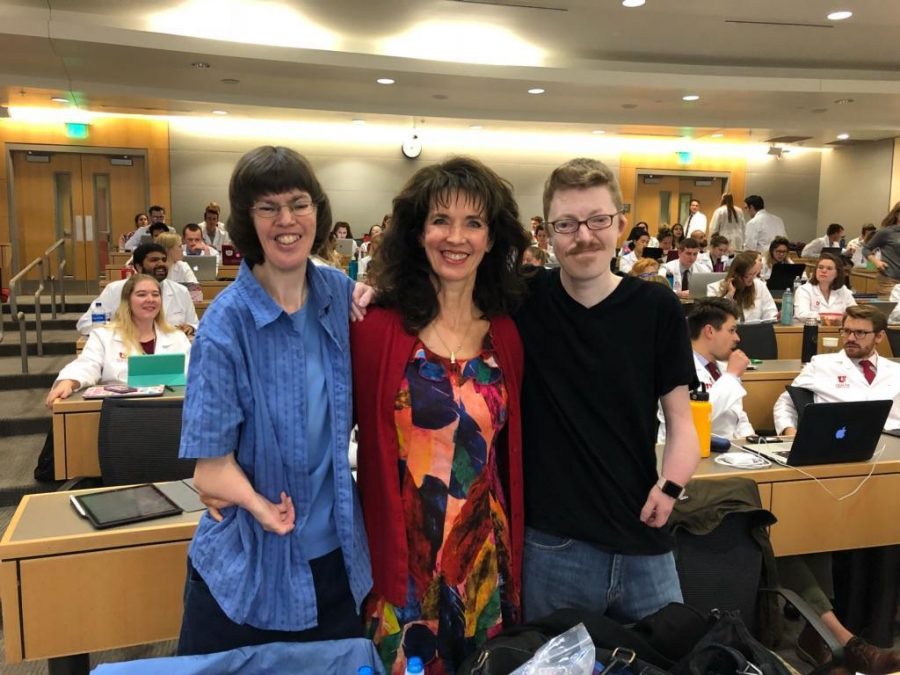“The first thing that I will tell you about today’s presentation is that it will not be on the exam,” said Dr. Lynn Jorde when addressing a classroom of first-year medical students on Oct. 8th. The presentation, which occurs annually, allows first-year medical students to “give a human face to medicine” through the experiences of siblings Logan and Heather Madsen as well as their mother, Dr. Jorde’s wife, Debbie Jorde.
“As a doctor, you will not only be treating the body, you will be tending to the needs of a person who is experiencing the trials and struggles of the human condition,” said Heather during her presentation. If a doctor were to read Heather’s or Logan’s charts they would likely discover that both suffer from two rare genetic disorders: Miller’s syndrome and Primary Ciliary Dyskinesia (PCD). The chances that these two distinct recessive genetic conditions should present themselves together are one in 10 billion, making Heather and Logan very rare medical anomalies. However, both Heather and Logan would like doctors to know that they are first and foremost humans with unique drives and passions and understanding this — as Heather stated during her talk — can help “doctor and patient work together as a team.”
How It All Began
When Debbie and her former husband Terry were married in 1976, they had the same hopes and dreams as most other young couples — “to have a family, have a home, have a dog and a white picket fence,” Debbie told medical students. When she became pregnant with Heather, she and her husband had no reason to think that their newest family member would be anything but healthy.
It was not until Heather was born in 1977 that the results of her unique conditions became apparent. Miller’s syndrome causes abnormal facial characteristics as well as an underdeveloped ulna and radius, resulting in unusually short forearms. A cleft palate made it extremely difficult to feed Heather as an infant. At the time, very little was known about Miller’s syndrome, as there were only 3 or 4 medical cases registered. Because of this, it took 18 months before a geneticist was able to correctly diagnose Heather with this syndrome.
“I don’t want this to be happening, I just want to go home, get pregnant again and have a different baby, because I don’t want this baby,” Debbie said, recalling her initial reaction of denial towards the discovery. She went on to recount the events that lead her heart to open up to Heather and to fall in love with her child. It was this love she said that has “carried me through all of the challenges we have faced.”
Because so little was known about the condition at the time, Debbie’s doctor had been certain that Miller’s syndrome was due to a gene mutation rather than a recessive trait for which both parents were carriers. He told Debbie that the chances that it would happen again were one in a million or less. When Logan was born with the same condition, the doctor said, “Congratulations, you have just made medical history.”
In fact, not only were Heather and Logan the first case of siblings both having Millers syndrome, but the entire family (Terry, Debbie, Heather and Logan) would go on to become the first family to have their entire genome sequenced. This lead to significant medical discoveries such as the human mutation rate. The results also allowed geneticists to locate the genes responsible for both genetic conditions of Miller’s syndrome and PCD. PCD affects the movement of cilia, tiny hairlike structures lining the airway, which allows mucus to be expelled through the body. This condition makes it easy for the lungs to become infected and affects both Heather’s and Logan’s breathing.
Debbie and Terry endured many challenges raising Heather and Logan, some of which were financial. The medical bills for procedures, visits and surgeries caused them to lose their home and car. Eventually, these difficulties contributed to the dissolution of their marriage. Debbie published a book in which she tells her story. Eight Fingers and Eight Toes: Accepting Life’s Challenge can be purchased through the family’s website.
Bigger Than My Challenges
Speaking to medical students, Heather said, “A patient is like a prism. Once you examine it you’ll discover a spectrum of light representing the unique essence of that prism.” Like a prism, a patient is unique and part of that uniqueness includes “habits, routines, lifestyle and their interests and pursuits.” She stated that “feelings and sense of self” should not be overlooked when reading a list of conditions and that it is important for a patient to “participate in their own healing process.”
During her talk, Heather spoke about her daily challenges. In addition to the challenges of living with Miller’s syndrome and PCD which make everyday life quite a bit more difficult for her than for most people, Heather is also hearing impaired and is autistic. This did not stop her from graduating from the University of Utah with a Bachelor of Science in Psychology and becoming a successful writer and public speaker. Through this work, she hopes to inspire others to overcome the challenges that life presents. She stated that what has helped her get through these challenges is a profound love for the beauty in life.
Heather’s writing, amongst other topics, details this “love affair with the beauty in the world.” Heather is currently in the process of writing a book. Her blog and information about future speaking engagements can be found on the family’s website.
Painter and Inventor
Logan began drawing at the age of two and discovered his love for painting in 2002 when going through a difficult time emotionally. During his presentation, he talked about the struggle to come to terms with his conditions while wanting to fit in with his peers. “Socially, the most obvious struggle is I look different, weird, everyone stares.”
Logan discussed the denial he faced when coming to terms with the challenges of being autistic, with which he was diagnosed late in his life. The struggle drove him to self-medicate and abuse various substances before seeking rehabilitation. Vocational rehab has since helped him set up his own business as an artist. This has helped him feel validated and a part of society as did his participation and volunteer work with the Utah Arts Alliance’s Connect program. Logan was a winner and recipient of the program’s grant in 2013.
Logan stated that one of the things that helped him come to terms with being autistic was finding a book about it that Heather had outlined. Since then, he has begun meeting with Heather every Sunday to discuss autism and its influence in their lives. He described the powerful realization as an understanding that the “unseen force I had been battling with my whole life was real and it had a description.” Logan stated that autism is a “confusing but an amazingly beautiful mess of virtually every facet of the human condition magnified.” His mind, he said, “is a universe full of introspective thought and extreme, extreme anxiety.”
Logan’s introspective thought expresses in many ways, one of which is painting, but Logan is also an inventor and a builder. He invents and creates custom assistive devices to help facilitate the difficulties of living with his condition. Logan is also a graphic designer and co-produced a documentary about his life with his best friend, Nathan Meier. The documentary, titled “Logan’s Syndrome,” won best feature documentary at the Carmel International Film Festival in 2017. Logan’s art can be viewed and purchased on his website.
Speaking at the U
Debbie and Lynn met for the first time on a blind date. “It was probably the first time the term postaxial acrofacial dysostosis was spoken during a first date,” said Lynn, referring to the medical name for Miller’s syndrome when introducing the family to his students. Dr. Lynn Jorde has been a faculty member at the U since 1979 and was appointed as chairman of the genetics department in 2009.
After the two had been dating for 3 years, Dr. Jorde invited Debbie to speak to his first-year medical students about her experience with doctors, hospitals and caring for Heather and Logan. Debbie said that “he felt like it would help give students a human face to medicine.” The talks went so well that they became a yearly event. Eventually, when Heather and Logan were old enough, they were able to take part and give their own presentations as well. While Dr. Jorde’s lectures generally only last 45 minutes, the talks were such a success with students that recently the department has made it a two-hour event.
“The very first question Logan ever got from a medical student was ‘what kind of car do you like?'” said Debbie, adding that “it was a great question because it showed Logan that they [medical students] saw him beyond his medical conditions.”
















Jean Mautner • Oct 18, 2018 at 1:03 pm
Great article! Thank you for using your talent for writing to look into the beauty and challenges of unique human lives!
.
Debbie Jorde • Oct 18, 2018 at 10:35 am
You did a great job covering our family’s story and our talks. Our mission is to use our challenges and overcoming them to make a positive difference in other people’s life’s. Thank you for helping us do this! Thank you Christina!